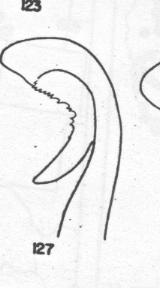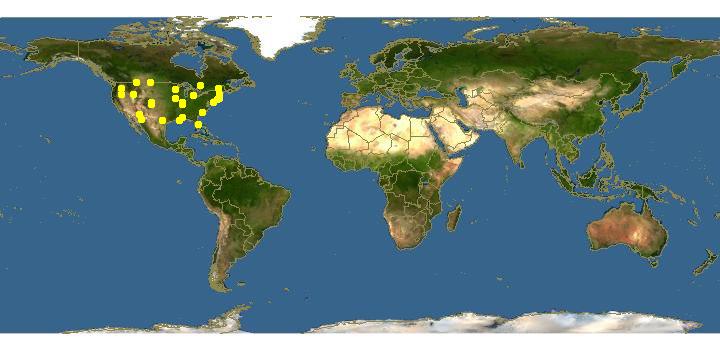
Arnold S. E. Menke, 1965 · 1
Ammophila kennedyi, male, penis valve head |

Click on map for details about points.
|
|
Overview |
Taken from: A Revision of the North American Ammophila (hymenoptera, Sphecidae). Arnold S. E. Menke, 1965.
Ammophila (Ammophila) kennedyi (Murray)
(Figs. 127, 147)
Ammophila vulgaris Cresson, 1865. Proc. Entomol. Soc. Philadelphia 4:458. Holotype female, Colorado (Academy of Natural Sciences, Philadelphia). Preoccupied by Ammophila vulgaris Kirby, 1798.
Sphex kennedyi Murray, 1938. Ann. Entomol. Soc. Amer, 31:36. New name for vulgaris Cresson.
Male. Average length 16.5 mm., range: 15-18.5 mm.
Color. Black; tegula often brownish posteriorly; petiole sternite reddish brown to black; petiole tergite red but often suffused vita brown dorsally; gastral segment I red (east of Rockies), or I-II red with black spot posteriorly on II (vest of Rockies); wings clear or slightly infumate (Florida), veins light brown to nearly black.
Vestiture, Appressed clypeal hair often thinning anteromedially, exposing sculpture; gena sometimes with sparse appressed silver hair along outer orbit; mesopleuron with a band of appressed silver hair from base of mid coxa to bottom of hypoepimeral area.
Structure. Labrum truncate; clypeal disk moderately to strongly bulging, densely micropunctate, sparsely macropunctate, shining; clypeal emargination very broad, shallow, bounded laterally by a raised tooth-like projection; collar densely micropunctate, moderately macropunctate; scutal surface shining, densely micropunctate, moderately to densely punctate, ridged; mesopleuron and inferior metapleural area shining, densely micropunctate, moderately macropunctate; propodeal side shining, densely macropunctate or punctatostriate; metapleural flange sometimes narrowly lamellate; right penis valve as in figure 127.
Female. Average length 17 mm., range: 13-23 mm.
Color. As in male except petiole tergite entirely red with black basodorsal spot; gastral tergite II completely red in western form.
Vestiture. Clypeus, frons, gena, collar, and scutum with sparse appressed brownish hair, facial hair infrequently partially silver; mesopleuron with a band of appressed silver hair from base of mid coxa to bottom of hypoepimeral area; lower metapleural area sometimes with a small poorly defined patch of appressed silver hair near hind coxa, patch occasionally crossing metapleural sulcus diagonally and extending onto propodeal side; psammophore brownish (eastern united states) or pale (western United states).
Structure. Labrum acuminate; clypeal disk moderately to strongly bulging, densely micropunctate, moderately macropunctate, median free margin projecting, teeth well developed; inner orbits slightly converging below; collar densely micropunctate, sparsely, finely macropunctate; scutum subshining, densely micropunctate or minutely reticulate, moderately macropunctate; scutellum moderately punctate, ridged; other details as in male.
Range. (fig. 147). Ammophila kennedyi is transcontinental in the United States and southern Canada. The species does not appear to occur in the southwestern desert areas.
Variation. This species exhibits east-west geographic variation with respect to vestiture and color. The Rocky Mountains form an approximate line between the western form of kennedyi and the typical eastern form. Eastern kennedyi have only gastral segment I red and females usually have a brownish psammophore. Western specimens have the second gastral segment partially red as well as segment I and the psammophore is pale. In addition, the appressed pleural hair is often denser and the bands somewhat broader in western examples. In densely pubescent specimens the mesopleural band of hair may extend nearly to the top of the hypoepimeral area. The clypeus of eastern kennedyi males is often strongly bulging and more highly polished than the western counterpart.
Ammophila Kennedyi from Florida and adjacent regions have lightly infumate wings and males sometimes have a narrow black stripe on gastral tergite I.
Systematics. The brown face and uniformily pubescent pronotal lobe will usually separate kennedyi females from related species. The normally brown veins and often narrowly lamellate metapleural flange are subsidiary recognition features in kennedyi. Males of this species can usually be identified by the entirely red first gastral segment. The broad process on the penis valve head is diagnostic also. See discussion under systematics of dysmica and urnaria for differences between these species and kennedyi.
The type of vulgaris has been examined. Fernald (1934) confused kennedyi (cited as vulgaris) with urnaria. Murray (1938) was the first to show that the two were distinct.
Ammophila urnaria Group
Diagnosis. Primary characters: Free margin of male clypeus emarginate (except in aberti and bellula) hypostoma in male simple, without a process (fig. 29); collar and scutum usually without strong transverse ridges (except in cleopatra) propodeal enclosure irregularly rugose medially, diagonally ridged laterally, interspaces smooth and/or punctate, subshining to shining, or sometimes minutely etched, dull (fig. 22); preepisternal sulcus short, ending about opposite pronotal lobe; metapleural flange not lamellate (except in leoparda, kennedyi sometimes, and aberti rarely); spine-like process of penis valve head basal, generally directed toward base of penis valve stalk (except in bellula) (rigs. 122-225, 127- 129); base of gonoforceps not dorsoventrally elongate. Secondary characters : Clypeus and frons with appressed silver hair (except kennedyi and urnaria females), male clypeus usually completely covered by appressed hair, obscuring underlying sculpture (except kennedyi, picipes and some urnaria), female clypeus glabrous anteromedially; pronotal lobe and propodeum adjacent to petiole socket covered with appressed silver hair (lobe of female urnaria with dense hair only posteriorly); erect body hair pale; psammophore pale (sometimes partially brownish in dysmica, juncea, kennedyi, picipes and urnaria) length of flagellomere I in male less than least interocular distance and greater than length of flagellomere II; middle tibia with two veil developed apical spurs (except in some aberti and dysmica) forewing with three submarginal cells.
Included North American species. Ammophila aberti Haldeman, bellula Menke, cleopatra Menke, dysmica Menke, hermosa Menke, juncea Cresson, kennedyi (Murray), leoparda (Fernald), mescalero Menke, parkeri Menke, picipes Cameron and urnaria Dahlbom. Other New World species belonging to the urnaria group but not dealt with in this paper are: A. dejecta Cameron (Mexico), gracilis Lepeletier, lampei Strand, rufipes Guérin-Méneville, and suavis Burmeister (all South American).
Discussion. The urnaria group is a difficult one because most of the species are very similar. Also, the male genitalia display specific differences only in a few species, aberti, bellula and kennedyi. The penis valve head of urnaria is quite variable (figs. 128-129) and the following species have aedeagi of the same general configuration: cleopatra, dysmica, hermosa, juncea, leoparda, mescalero, parkeri and picipes. Of prime importance for species discrimination in the urnaria group ii the pattern of appressed hair on the mesosoma, particularly the pleural region. Unfortunately, old or worn specimens make hair patterns difficult to use, and often it is impossible to identify material in this condition without a thorough knowledge of the group. Some species have characteristic markings on the abdomen and a few have bicolored legs or other chromatic peculiarities. Structurally the urnaria group is fairly homogeneous with nearly all species having similar punctation etc. Some differences are found in the shape of the labrum but here also there is variability. Clypeal structure is sometimes distinctive but it is difficult to describe. The possibility of using various head measurements in species diagnosis has not been fully explored in the urnaria group. Comparisons of the lengths of flagellomeres I and II and also of the least interocular distance versus the length of flagellomere I seem to have no value, at least for the distinction of difficult species. Other measurements might be made in search of better species criteria: overall head width, eye width, length of head and degree of eye convergence, for example.
The six species that are the most difficult to identity can be divided into two groups of black-legged species. In one group, the mesopleural band of appressed hair ends at the bottom of the hypoepimeral area (dysmica, kennedyi and urnaria). In the second group the band extends to the top of the hypoepimeral area juncea, and picipes). A few species in the urnaria group seem to have no close allies: Ammophila aberti, bellula, leoparda and mescalero.
The arvensis group proposed by Fernald (1934) contained species belonging to the urnaria group and the azteca group. Fernald’s concept included pilosa (Fernald) (= azteca Cameron), arvensis Dahlbom (an Old World name used in error for mediata Cresson, evansi Menke and possibly other species), floridensis (Fernald) (= urnaria Dahlbom), urnaria Dahlbom (Fernald confused kennedyi and possibly other species with urnaria), and leoparda (Fernald) as variety of urnaria). The similar pleural pubescence pattern exhibited by these species was apparently the only criterion used by Fernald for this unnatural assumblage of species.
The urnaria group is represented throughout the New World, but appears to have no Old World allies.
|
|
|
Names | |
|
|
| Supported by | |
Updated: 2024-04-18 00:17:13 gmt
|